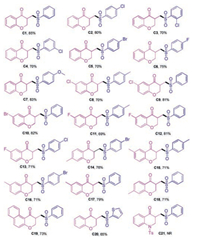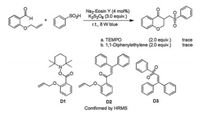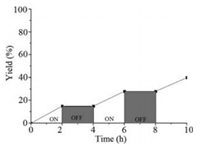b College of Chemistry and Chemical Engineering, Yantai University, Yantai 264005, China;
c School of Chemistry and Chemical Engineering, Hunan University of Science and Technology, Xiangtan 411201, China
Substituted chroman-4-ones are important structural motifs existing in many biological and medicinal compounds [1-5]. Consequently, the development of efficient and ecofriendly begin protocols for their preparation is a hot topic in organic synthesis [6-13]. Using o-(allyloxy)arylaldehydes as substrate via cascade radical cyclization represents one of the most efficient synthetic methods. For example, the reaction of α-oxocarboxylic acids and o-(allyloxy)arylaldehydes was described by Wu group in 2017. With ammonium persulfate as oxidant, the desired products were obtained with moderate to good yields (Scheme 1a) [14]. A series of phosphonates, azides and hydroxy functionalized chroman-4-ones were developed by Li group. An intramolecular addition reaction of an acyl radical and alkene, followed by a selective nucleophilic radical–electrophilic radical cross coupling was proposed for this transformation (Scheme 1b) [15]. Yu group found that 1, 3-dicarbonyl compounds (Scheme 1c) [16] and tert-carboxylic acids (Scheme 1d) [17] were also good partners for this cyclization. CF3-Functionalized chroman-4-ones were also developed by Tang group. Control experiments and DFT calculations indicated that the oxidation of CF3SO2Na to ·CF3 by K2S2O8 was involved in the rate determining step (Scheme 1e) [18]. However, harsh reaction conditions such as use of metal catalyst and high temperature are not ecofriendly and limit their widespread applications.

|
Download:
|
| Scheme 1. Synthesis of chroman-4-one derivatives. | |
Visible light as a clean energy source has been widely used in organic synthesis [19-25]. At present, various reactions such as C—C [26-28], C—O [29-31], C—N [32-36] bond activation reactions and others [37-41] have been successfully conducted in the presence of visible light. Among these photo-induced reactions, sulfonylation reaction continues to thrive [42]. At present, arylsulfinic acids or salts [43-48], sulfonyl chlorides [49, 50], sulfonyl hydrazides [51, 52] and sulfur dioxide [53, 54] have all been used as sulfonyl sources. In spite of the significant advances, the exploration of photo-induced methodology to some complicated sulfone-containing skeletons still remains highly desirable. In line with our interest in heterocyclic compound synthesis and visible-light induced reactions [55-60], herein, we reported a visible-light induced method for the synthesis of sulfonated chroman-4-ones derivatives.
In the beginning, a model reaction of 1-(2-(allyloxy)phenyl) ethanone (A) with benzenesulfinic acid (B) was chosen to optimize the reaction conditions. As shown in Table 1, several solvents were tested under the irradiation of 8 W blue LED for 24 h under room temperature (Table 1, entries 1–6). Acetone:H2O (v/v = 1:1) give the highest yield (85%). Subsequently, we examined the effect of different oxidants such as TBHP (tert-butyl hydroperoxide), DTBP (di-tert-butyl peroxide), (NH4)2S2O8, Na2S2O8 and TBPB (tert-butyl peroxybenzoate) (Table 1, entries 7–11), and it was found that K2S2O8 was the optimal oxidant. Encouraged by this result, we next turn our attention to investigate the effect of catalysts on the reaction. When Rose Bengal was used as a catalyst for this reaction, only 44% yield of the desired product was obtained (Table 1, entry 12). Other catalysts also led to slower reactions (Table 1, entries 13–16). The yields of the products decreased significantly in the absence of light source, oxidant or catalyst (Table 1, entries 17–19), implying their important roles in this transformation.
|
|
Table 1 Optimization of the reaction conditions.a |
With the optimum reaction conditions in hand, we began to investigate the substrate scope of the visible light-initiated cascade radical cyclization of sulfinic acids and o-(allyloxy)arylaldehydes, and the results are summarized in Scheme 2. Whether the phenyl rings of sulfinic acids are attached with electron-withdrawing, electron-donating groups or sterically hindered groups, the target products can be isolated with good to excellent yields (C1-C7). For example, Cl, Br, F, CH3O and CH3 groups are all well tolerated in this protocol, implying little electronic effect on this reaction. To evaluate the scope of o-(allyloxy)arylaldehydes, the effect of substituent on o-(allyloxy)arylaldehydes was also examined. o-(Allyloxy)arylaldehydes bearing electron-donating or electron-withdrawing groups such as Cl, Br, F and CH3 are all suitable for this transformation, providing the corresponding products with good yields (C8-C18). It should be noted that 2-(allyloxy)-1-naphthaldehyde and thiophene-2-sulfinic acid are also compatible with this method, providing the products C19 and C20 in 73% and 65% yields. Furthermore, halogen groups are well tolerated in this system, rendering the products for further modifications readily. To our disappointment, when 2-N(Ts)CH2—CH=CH2 substituted benzaldehyde was applied to this reaction, no product was obtained (C21).

|
Download:
|
| Scheme 2. Substrate scope of the visible light-initiated cascade radical cyclization of sulfinic acids and o-(allyloxy)arylaldehydes. Reaction conditions: o-(allyloxy) arylaldehydes (0.2 mmol), sulfinic acids (0.6 mmol), catalyst (4 mol%), K2S2O8 (3.0 equiv.), 8 W blue LED, solvent (2 mL, 1:1), r.t., 24 h. | |
In order to demonstrate the practicality of the present protocol, a gram-scale reaction was conducted under the standard conditions. To our delight, this scale-up reaction provided the corresponding product C1 in 83% isolated yield (Scheme 3). This result showed the practical applicability of the new protocol.

|
Download:
|
| Scheme 3. Gram-scale synthesis. | |
To gain some insight into the mechanism, a series of control experiments were carried out. As shown in Scheme 4, when 2 equiv. of TEMPO (2, 2, 6, 6-tetramethyl-1-piperidinyloxy) or 1, 1-diphenylethylene as the radical scavengers were added to the reaction, respectively, the cyclization reactions were inhibited. Only a trace amount of desired product was formed. Intermediate D1, D2 and D3 have been confirmed by HRMS. These results indicated that a radical process may be involved in this cascade reaction. In addition, the result of on/off visible-light irradiation experiments demonstrated that the continuous irradiation of visible light is necessary for this reaction (Fig. 1).

|
Download:
|
| Scheme 4. Control experiments. | |

|
Download:
|
| Fig. 1. On/off experiments. | |
Based on the experimental results described above and previous literatures [14-18, 61, 62], a possible reaction pathway was proposed in Scheme 5. Firstly, Na2·eosin Y* was formed from visible-light-excitation of Na2·eosin Y. Then, sulfinic acid was oxidized by Na2·Eosin Y*, generating the sulfonyl radical cation M1 and radical anion Na2·Eosin Y·-. Sulfonyl radical cation M1 was deprotonated by SO4·-, resulting sulfonyl radical M2. At the same time, o-(allyloxy)arylaldehydes M4 could be oxidized by K2S2O8 through a single-electron transfer process to generate radical M5. Subsequently, M5 underwent cyclization reaction to give radical M6. Finally, the desired product M7 was formed from the reaction of intermediate M6 and sulfonyl radical M2. Additionally, another reaction pathway, alkene sulfonylation followed by intramolecular addition to aldehyde, 1, 2-HAT, and oxidative deprotonation was not completely excluded.

|
Download:
|
| Scheme 5. Reaction mechanism. | |
With a view to discovering the biological activity of these desired products, several products from Scheme 2 were preliminarily screened for anti-microbial activity using mycelia growth inhibitory rate methods. As can be seen from Table 2, products we tested exhibited moderate inhibitory activity against Valsa mali and C. glecosporioides. These results will be useful for further research and development of pesticides.
|
|
Table 2 Anti-microbial activity of synthetic compounds (50 mg/L). |
In conclusion, we have presented an efficient method for the synthesis of functionalized chroman-4-ones induced by visible light via the radical cyclization reaction of sulfinic acids and o-(allyloxy)arylaldehydes. The corresponding products were isolated with moderate to good yields. Radical mechanism was proposed for this transformation. We believe that this method to access chroman-4-ones has the potential for multiple applications, and more reactions for synthesizing highly functionalized chroman-4-ones induced by visible light may be presented. Further studies into the reaction mechanism and bioactivity are ongoing in our lab.
Declaration of competing interestThe authors declare that they have no known competing financial interests or personal relationships that could have appeared to influence the work reported in this paper.
AcknowledgmentsThis work was supported by the National Natural Science Foundation of China (No. 21772107), and Shandong Province Key Research and Development Plan (No. 2019GSF108017). We also thank Cai-Zhen Ding, Yan-Li Wang and Hong-Di Yang for their useful help.
Appendix A. Supplementary dataSupplementary material related to this article canbefound, in the online version, at doi:https://doi.org/10.1016/j.cclet.2020.03.007.
| [1] |
T. Seifert, M. Malo, T. Kokkola, et al., J. Med. Chem. 57 (2014) 9870-9888. DOI:10.1021/jm500930h |
| [2] |
T. Nishida, H. Yoshinaga, T. Toyoda, M. Toshima, Org. Process Res. Dev. 16 (2012) 625-634. DOI:10.1021/op200357h |
| [3] |
A. Gaspar, M.J. Matos, J. Garrido, E. Uriarte, F. Borges, Chem. Rev. 114 (2014) 4960-4992. DOI:10.1021/cr400265z |
| [4] |
J. Fan, W. Sun, Z. Wang, et al., Chem. Commun. 50 (2014) 9573-9576. DOI:10.1039/C4CC03778B |
| [5] |
L. Peng, Z. Hu, Z. Tang, Y. Jiao, X. Xu, Chin. Chem. Lett. 30 (2019) 1481-1487. DOI:10.1016/j.cclet.2019.04.008 |
| [6] |
S. Jung, J. Kim, S. Hong, Adv. Synth. Catal. 359 (2017) 3945-3949. DOI:10.1002/adsc.201701072 |
| [7] |
N.N. Zhou, M.X. Wu, M. Zhang, X.Q. Zhou, Asian J. Org. Chem. 8 (2019) 828-831. DOI:10.1002/ajoc.201900121 |
| [8] |
M.Y. Chang, Y.S. Wu, H.Y. Chen, Org. Lett. 20 (2018) 1824-1827. DOI:10.1021/acs.orglett.8b00316 |
| [9] |
X.K. He, B.G. Cai, Q.Q. Yang, L. Wang, J. Xuan, Chem. Asian J. 14 (2019) 3269-3273. DOI:10.1002/asia.201901078 |
| [10] |
Q. Liu, G.Q. Xie, Q. Wang, et al., Tetrahedron 75 (2019) 130490-130498. DOI:10.1016/j.tet.2019.130490 |
| [11] |
J. Sheng, J.D. Liu, L.Q. Chen, et al., Org. Chem. Front. 6 (2019) 1471-1495. DOI:10.1039/C9QO00292H |
| [12] |
(a) Y.M. Xiao, Y. Liu, W.P. Mai, et al., ChemistrySelect 4(2019) 1939-1942; (b) D. Lu, Y. Wan, L. Kong, G. Zhu, Org. Lett. 19(2017) 2929-2932. |
| [13] |
F.H. Xiao, C. Liu, D.H. Wang, H.W. Huang, G.J. Deng, GreenChem. 20 (2018) 973-977. |
| [14] |
W.C. Yang, P. Dai, K. Luo, Y.G. Ji, L. Wu, Adv. Synth. Catal. 359 (2017) 2390-2395. DOI:10.1002/adsc.201601407 |
| [15] |
J.J. Zhao, P. Li, X.J. Li, C.G. Xia, F.W. Li, Chem. Commun. 52 (2016) 3661-3664. DOI:10.1039/C5CC09730D |
| [16] |
H. Hu, X.L. Chen, K. Sun, et al., Org. Lett. 20 (2018) 6157-6160. DOI:10.1021/acs.orglett.8b02627 |
| [17] |
H. Hu, X.L. Chen, K. Sun, et al., Org. Chem. Front. 5 (2018) 2925-2929. DOI:10.1039/C8QO00882E |
| [18] |
L. Tang, Z. Yang, X.P. Chang, et al., Org. Lett. 20 (2018) 6520-6525. DOI:10.1021/acs.orglett.8b02846 |
| [19] |
J. Zhu, W.C. Yang, X.D. Wang, L. Wu, Adv. Synth. Catal. 360 (2018) 386-400. DOI:10.1002/adsc.201701194 |
| [20] |
(a) W.J. Zhou, Y.H. Zhang, Y.Y. Gui, L. Sun, D.G. Yu, Synthesis 50(2018) 3359-3378; (b) Z. Cao, Q. Zhu, Y.W. Lin, W.M. He, Chin. Chem. Lett. 30(2019) 2132-2138. |
| [21] |
K. Luo, W.C. Yang, L. Wu, Asian J. Org. Chem. 6 (2017) 350-367. DOI:10.1002/ajoc.201600512 |
| [22] |
C. Huang, X.B. Li, C.H. Tung, L.Z. Wu, Chem. Eur. J. 24 (2018) 11530-11534. DOI:10.1002/chem.201800391 |
| [23] |
(a) D. Staveness, I.C. Bosque, R.J. Stephenson, Acc. Chem. Res. 49(2016) 2295-2306; (b) W. Yang, B. Li, M. Zhang, et al., Chin. Chem. Lett. 31(2020) 1313-1316; (c) L.Y. Xie, Y.S. Lu, H.R. Ding, et al., Chin. J. Catal. 41(2020) 1168-1173. |
| [24] |
(a) T. Courant, G. Masson, J. Org. Chem. 81(2016) 6945-6952; (b) H. Xu, Y. Zhang, X. Lang, Chin. Chem. Lett. 31(2020) 1520-1524. |
| [25] |
D.C. Fabry, M. Rueping, Acc. Chem. Res. 49 (2016) 1969-1979. DOI:10.1021/acs.accounts.6b00275 |
| [26] |
S. Cao, S.S. Zhong, L.T. Xin, J.P. Wan, C.P. Wen, ChemCatChem 7 (2015) 1478-1482. DOI:10.1002/cctc.201500139 |
| [27] |
S.Q. Zhu, A. Das, L. Bui, et al., J. Am. Chem. Soc. 135 (2013) 1823-1829. DOI:10.1021/ja309580a |
| [28] |
X.Y. Yu, J.R. Chen, P.Z. Wang, et al., Angew. Chem. Int. Ed. 57 (2018) 738-743. DOI:10.1002/anie.201710618 |
| [29] |
H. Im, D. Kang, S. Choi, S. Shin, S. Hong, Org. Lett. 20 (2018) 7437-7441. DOI:10.1021/acs.orglett.8b03166 |
| [30] |
L. Zhang, J. Zhu, J. Ma, L. Wu, W.H. Zhang, Org. Lett. 19 (2017) 6308-6311. DOI:10.1021/acs.orglett.7b03052 |
| [31] |
G. Magallanes, M.D. Kärkäs, I. Bosque, et al., ACS Catal. 9 (2019) 2252-2260. DOI:10.1021/acscatal.8b04172 |
| [32] |
(a) H. Kaur, M. Kaur, P.K. Walia, M. Kumar, V. Bhalla, Chem. Asian J. 14(2019) 809-813; (b) L.Y. Xie, J.L. Hu, Y.X. Song, et al., ACS Sustainable Chem. Eng. 7(2019) 19993-19999. |
| [33] |
W. Wei, P.L. Bao, H.L. Yue, et al., Org. Lett. 20 (2018) 5291-5295. DOI:10.1021/acs.orglett.8b02231 |
| [34] |
M. Lanzi, J. Merad, D.V. Boyarskaya, et al., Org. Lett. 20 (2018) 5247-5250. DOI:10.1021/acs.orglett.8b02196 |
| [35] |
Q.M. Kainz, C.D. Matier, A. Bartoszewicz, et al., Science 351 (2016) 681-684. DOI:10.1126/science.aad8313 |
| [36] |
(a) T.Y. Shang, L.H. Lu, Z. Cao, et al., Chem. Commun. 55(2019) 5408-5419; (b) W.B. He, L.Q. Gao, X.J. Chen, et al., Chin. Chem. Lett. 31(2020) 1895-1898. |
| [37] |
Y. Gao, Y.Y. Liu, J.P. Wan, J. Org. Chem. 84 (2019) 2243-2251. DOI:10.1021/acs.joc.8b02981 |
| [38] |
(a) D. Yang, G. Li, C. Xing, et al., Org. Chem. Front. 5(2018) 2974-2979; (b) X. Mi, Y. Kong, J. Zhang, C. Pi, X. Cui, Chin. Chem. Lett. 30(2019) 2295-2298. |
| [39] |
Q.S. Liu, L.L. Wang, H.L. Yue, et al., Green Chem. 21 (2019) 1609-1613. DOI:10.1039/C9GC00222G |
| [40] |
Y. Yasu, T. Koike, M. Akita, Org. Lett. 15 (2013) 2136-2139. DOI:10.1021/ol4006272 |
| [41] |
(a) G. Li, Q. Yan, Z. Gan, et al., Org. Lett. 21(2019) 7938-7940; (b) X. Gong, Y. Ding, X. Fan, J. Wu, Adv. Synth. Catal. 359(2017) 2999-3004. |
| [42] |
(a) J. Zhu, W.C. Yang, X.D. Wang, L. Wu, Adv. Synth. Catal. 360(2018) 386-400; (b) W. Yang, S. Yang, P. Li, L. Wang, Chem. Commun. 51(2015) 7520-7523. |
| [43] |
(a) X.S. Wu, Y. Chen, M.B. Li, M.G. Zhou, S.K. Tian, J. Am. Chem. Soc. 134(2012) 14694-14697; (b) L. Wang, M. Zhang, Y. Zhang, et al., Chin. Chem. Lett. 31(2020) 67-70; (c) L.Y. Xie, Y.L. Chen, L. Qin, et al., Org. Chem. Front. 6(2019) 3950-3955. |
| [44] |
Y.M. Xi, B.L. Dong, E.J. McClain, et al., Angew. Chem. Int. Ed. 53 (2014) 4657-4661. DOI:10.1002/anie.201310142 |
| [45] |
(a) W. Wei, H. Cui, D. Yang, et al., Org. Chem. Front. 4(2017) 26-30; (b) L. Wang, M. Zhang, Y. Zhang, et al., Chin. Chem. Lett. 31(2020) 67-70. |
| [46] |
L.Y. Xie, S. Peng, F. Liu, et al., Org. Chem. Front. 5 (2018) 2604-2609. DOI:10.1039/C8QO00661J |
| [47] |
W. Li, G. Yin, L. Huang, et al., Green Chem. 18 (2016) 4879-4883. DOI:10.1039/C6GC01196A |
| [48] |
L. Xie, T. Fang, J. Tan, et al., Green Chem. 21 (2019) 3858-3863. DOI:10.1039/C9GC01175G |
| [49] |
S. Kamijo, M. Hirota, K. Tao, M. Watanabe, T. Murafuji, Tetrahedron Lett. 55 (2014) 5551-5554. DOI:10.1016/j.tetlet.2014.08.011 |
| [50] |
(a) L.Y. Xie, S. Peng, J.X. Tan, et al., ACS Sustainable Chem. Eng. 6(2018) 16976-16981; (b) P. Qian, Y. Deng, H. Mei, et al., Org. Lett. 19(2017) 4798-4801; (c) L.Y. Xie, Y.J. Li, J. Qu, et al., Green Chem. 19(2017) 5642-5646; (d) P. Bao, L. Wang, Q. Liu, et al., Tetrahedron Lett. 60(2019) 214-218. |
| [51] |
S. Cai, Y. Xu, D. Chen, et al., Org. Lett. 18 (2016) 2990-2993. DOI:10.1021/acs.orglett.6b01353 |
| [52] |
(a) L. Wang, Y. Zhang, M. Zhang, et al., Tetrahedron Lett. 60(2019) 1845-1848; (b) W.H. Bao, Z. Wang, X. Tang, et al., Chin. Chem. Lett. 30(2019) 2259-2262. |
| [53] |
Y. Li, D. Zheng, Z. Li, J. Wu, Org. Chem. Front. 3 (2016) 574-578. DOI:10.1039/C6QO00060F |
| [54] |
Y. Xiang, Y. Li, Y. Kuang, J. Wu, Chem. Eur. J. 23 (2017) 1032-1035. DOI:10.1002/chem.201605336 |
| [55] |
D.Q. Dong, L.X. Li, G.H. Li, et al., Chin. J. Catal. 40 (2019) 1494-1498. DOI:10.1016/S1872-2067(19)63420-0 |
| [56] |
G.H. Li, D.Q. Dong, Q. Deng, S.Q. Yan, Z.L. Wang, Synthesis 51 (2019) 3313-3319. DOI:10.1055/s-0037-1611787 |
| [57] |
(a) D.Q. Dong, W.J. Chen, Y. Yang, X. Gao, Z.L. Wang, ChemistrySelect 4(2019) 2480-2483; (b) Q.Q. Han, G.H. Li, Y.Y. Sun, et al., Tetrahedron Lett. 61(2020) 151704. |
| [58] |
(a) G.H. Li, D.Q. Dong, X.Y. Yu, Z.L. Wang, New J. Chem. 43(2019) 1667-1670; (b) S.H. Hao, L.X. Li, D.Q. Dong, Z.L. Wang, Chin. J. Catal. 38(2017) 1664-1667; (c) D.Q. Dong, S.H. Hao, H. Zhang, Z.L. Wang, Chin. Chem. Lett. 28(2017) 1597-1599. |
| [59] |
(a) D.Q. Dong, W.J. Chen, D.M. Chen, et al., Chin. J. Org. Chem. 39(2019) 3190-3198; (b) S. Yan, D.Q. Dong, C. Xie, W. Wang, Z.L. Wang, Chin. J. Org. Chem. 39(2019) 2560-2566. |
| [60] |
G.H. Li, D.Q. Dong, Y. Yang, X.Y. Yu, Z.L. Wang, Adv. Synth. Catal. 361 (2019) 832-835. |
| [61] |
L.Y. Xie, T.G. Fang, J.X. Tan, et al., Green Chem. 21 (2019) 3858-3863. DOI:10.1039/C9GC01175G |
| [62] |
(a) W. Wei, H. Cui, D. Yang, et al., Green Chem. 19(2017) 5608-5613; (b) S. Peng, Y.X. Song, J.Y. He, et al., Chin. Chem. Lett. 30(2019) 2287-2290. |
 2020, Vol. 31
2020, Vol. 31 



